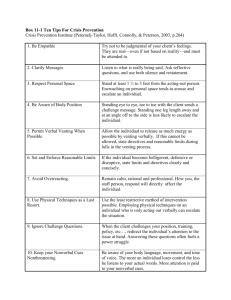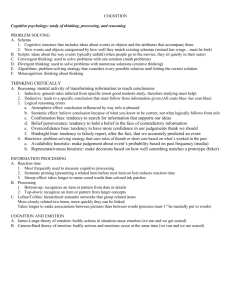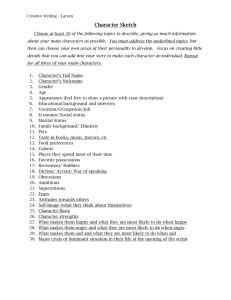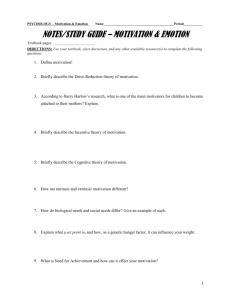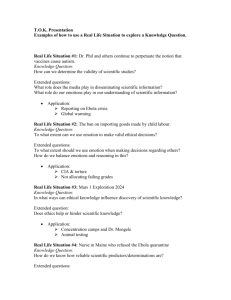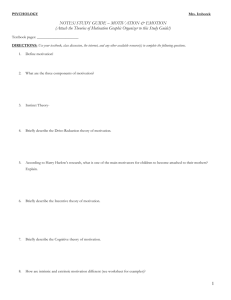Proactive Problem Solving & Constructive Conflict Communications
advertisement
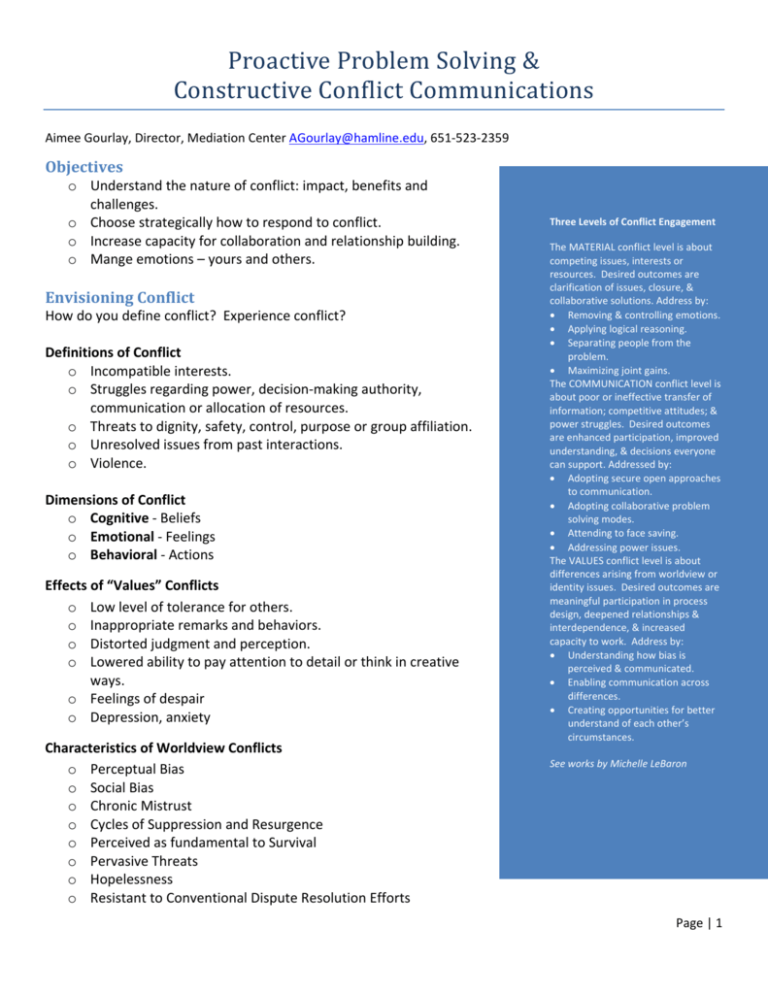
ProactiveProblemSolving& ConstructiveConflictCommunications Aimee Gourlay, Director, Mediation Center AGourlay@hamline.edu, 651‐523‐2359 Objectives o Understand the nature of conflict: impact, benefits and challenges. o Choose strategically how to respond to conflict. o Increase capacity for collaboration and relationship building. o Mange emotions – yours and others. EnvisioningConflict How do you define conflict? Experience conflict? Definitions of Conflict o Incompatible interests. o Struggles regarding power, decision‐making authority, communication or allocation of resources. o Threats to dignity, safety, control, purpose or group affiliation. o Unresolved issues from past interactions. o Violence. Dimensions of Conflict o Cognitive ‐ Beliefs o Emotional ‐ Feelings o Behavioral ‐ Actions Effects of “Values” Conflicts o Low level of tolerance for others. o Inappropriate remarks and behaviors. o Distorted judgment and perception. o Lowered ability to pay attention to detail or think in creative ways. o Feelings of despair o Depression, anxiety Characteristics of Worldview Conflicts o Perceptual Bias o Social Bias o Chronic Mistrust o Cycles of Suppression and Resurgence o Perceived as fundamental to Survival o Pervasive Threats o Hopelessness o Resistant to Conventional Dispute Resolution Efforts Three Levels of Conflict Engagement The MATERIAL conflict level is about competing issues, interests or resources. Desired outcomes are clarification of issues, closure, & collaborative solutions. Address by: Removing & controlling emotions. Applying logical reasoning. Separating people from the problem. Maximizing joint gains. The COMMUNICATION conflict level is about poor or ineffective transfer of information; competitive attitudes; & power struggles. Desired outcomes are enhanced participation, improved understanding, & decisions everyone can support. Addressed by: Adopting secure open approaches to communication. Adopting collaborative problem solving modes. Attending to face saving. Addressing power issues. The VALUES conflict level is about differences arising from worldview or identity issues. Desired outcomes are meaningful participation in process design, deepened relationships & interdependence, & increased capacity to work. Address by: Understanding how bias is perceived & communicated. Enabling communication across differences. Creating opportunities for better understand of each other’s circumstances. See works by Michelle LeBaron Page | 1 Six“Linked”IdeasforConstructiveConflictCommunications 1. ReducingMistrustThoughIntegrity&Transparency o Keep track of what you promise to do (follow up, questions to answer) and do it. o Provide feedback loops. If you gather information, report what you learn. o Summarize and give participants the opportunity to clarify misunderstandings. 2. AndPerceived“Fairness”inYourResponse o o o o Meaningful opportunity to speak. Treated all participants with dignity and respect. Received assurance that responder has listened to their story and cared about what was said. People prefer “voice” to “mute.” (Greenberg & Folger, 1983) And are more likely to judge the interaction as “fair,” even if they do not agree with the outcome. 3. RequiresAskingandActiveListening o o o o o Focus Attend Clarify Empathize Summarize 4. ToGet(NotTake)Others’Perspectives o “If your belief about the other side’s perspective is mistaken, then carefully considering that person’s perspective will only magnify the mistake’s consequences.” (Nicholas Epley, Mindwise: How We Understand What Others Think, Believe, Feel and Want). 5. AndUnderstandOthers’Interests o Issues: Topics or items that must be discussed to arrive at an agreement – the agenda or “what.” o Positions: How a negotiator believes the deal or dispute should be resolved – their solution or “how.” o Interests: Needs, wants or concerns which underlie the solution, often unspoken and/or intangible – the “why.” 6. InOrdertoShiftfromDebatetoDialogue,SolveProblems,andImproveRelationships. Page | 2 Emotions Venting out an emotion does not reduce it. (Carol Travis, Anger: The Misunderstood Emotion) If you respond to “hot” emotion with heat and anger, you are likely to escalate the situation. It is very difficult for someone to stay escalated if you are calm. Different things work for different people. Here are some ideas for maintaining your own emotional control: 1) Assume the other person has a legitimate reason to be angry (from their perspective) 2) Listen to emotion without emotion 3) Be patient 4) Speak softly and slowly 5) Take a brief pause if you need one 6) Breathe deeply (calming breaths are as “catching” as yawns) 7) Take your time formulating a response and moderate your initial reaction 8) Ask the person a question that requires them to think logically 9) Focus on the end of your nose rather than the other person 10) Keep at least three feet (or your own “safe distance”) by backing away if someone is coming at you. Don’t back yourself into a corner, though. Step towards an exit or other people. 11) Anything else that helps you control your reactions. De‐Escalation Escalate Interrupt or ignore the angry person De‐escalate Listen patiently and carefully. Summarize what you have heard, ask clarifying questions. Show by your voice and/or body language that you are paying attention. Yell, curse, etc. Speak slowly and calmly Insist you get things settled “right now.” Take a break. Tell the angry person you contact them later. “Letting off steam” or uncontrolled venting. Take a deep breath, brief pause. Ask a question that requires someone to think cognitively about the answer and redirects their Making the problem personal … between you and Viewing the problem objectively … something you can solve them. together. Explain why the angry person is “wrong” and why Actively empathize … show the angry person that you they should not feel the way they do. understand their perspective (even if you don’t agree with it). Joke if they are not joking Model how you wish to be treated Argumentation, defensiveness or debate Deflect, understand, share information Capitulate to get rid of someone (with no intention Follow up, and do what you say you will of following up) Respond with facts, figures and/or technical Restate what you heard them say to make sure you are information to refute their point understanding “To be honest” or “In my opinion” invite argument “What I hear you saying” or “Help me understand” or “So that I can help you …” invite discussion and problem solving. Page | 3 PublicSectorEngagement Improveddecisionsbasedonsharedunderstanding Stakeholders may learn about a policy or project and the process for decision making, ask questions, give input, jointly solve problems, or (less frequently) make decisions. Meaningful engagement includes: Opportunities for stakeholders to develop knowledge in order to make informed choices or give feedback Clarity and transparency in decision‐making process Community empowerment and support Effective conflict management Enhanced communications between decision‐makers and public groups WhyEngagewiththePublic? (You already are) Alter the dynamics of debate by developing dialogue Slow down to speed up – long term effectiveness Reduces assumptions and perceptual bias Durable outcomes Builds relationships & reduces mistrust Not responding is a response Definition Stakeholder engagements are processes by which an organization involves people who may be affected by the decisions it makes or can influence the implementation of its decisions. They may support or oppose the decisions, be influential in the organization or within the community in which it operates, hold relevant official positions or be affected in the long term. Wikipedia RelationshipFocusedPublicEngagementModel A relationship focused public engagement process may be a good idea if your assessment reveals the following: There are overlapping interests (compromise/negotiation is possible) Desired outcomes are do‐able within the scope of the project (you can possibly relocate a maintenance station along a proposed route, you cannot immediately reduce the nation’s dependency on petroleum) You have your internal leadership’s support You have political and agency support and your approach will comply with regulatory requirements Stakeholders are willing to participate Issue is ready for discussion … at least preliminary information is available to the public, and there is a need to address the issues The issues are complex and/or controversy is high, and potential benefits from the investment of resources are identified Resources are available Identified employees/consultants have the skills and capacity to engage with the public ConsultandCollaborate–RelationshipBuildingEngagements Key principles in for consultative engagement: Provide meaningful information in a format that is readily understandable and tailored to the needs of the group Provide information in advance of consultation and/or decision‐making Share information in ways and locations that allow ease of access by stakeholders Demonstrate respect for local traditions Page | 4 Provide dialogue ‐ the opportunity to exchange views and information, to listen, and to be heard and have issues addressed Demonstrate inclusiveness Participants do not feel intimidated or coerced Clear process for responding to feedback Incorporate feedback into project and report back to stakeholders The agency is committed to the process and is willing to provide the necessary resources to see it through It takes commitment to follow the key principles. It can be harmful to take on a significant public engagement initiative half‐heartedly or conditionally. Before you begin your initiative, be sure that you can confirm the following statements:1 Agency/Organizational ⎕You and your team have a shared understanding of what you want to achieve through engagement and what is on the table. ⎕Engagement is not a substitute for reflection and thought within your organization. ⎕You have senior support for the method of engagement. ⎕You are able to coordinate information and actions across the organizations involved. ⎕You are clear about what information you are seeking and how you or the community will use it. ⎕You know with whom you need to engage for this topic. Public Needs ⎕ You are trying to ensure that your project meets the public’s interests ⎕ You will explain to participants why they are being consulted and for what their answers will be used. ⎕ You know how you will feed back what you have learned to the community. ⎕ You are trying to gain an understanding from all stakeholders and are open to change. ⎕ You have relevant information that is readily accessible to all members of the community. ProceduralFairness The three most important factors impacting whether a stakeholder perceives a process to be “fair” are: Having a meaningful opportunity to tell their story. Receiving assurance that responder has listened to their story and cared about what was said. Treating all participants with dignity and respect. There is a significant body of research indicating that when disputants perceive that they have been treated in a procedurally fair manner, they are more likely to deem the process as fair, even if the outcome is unfavorable. 1 From the work of the non‐profit organization, Involve, in the UK. Page | 5 LevelEngagementbyDegreeofStakeholders’Influence&Interest Low interest High influence High interest High influence Keep Satisfied inform & consult Less Effort inform Low interest Low influence Work Together inform, consult & collaborate Consideration consult & inform High interest Low influence Page | 6


